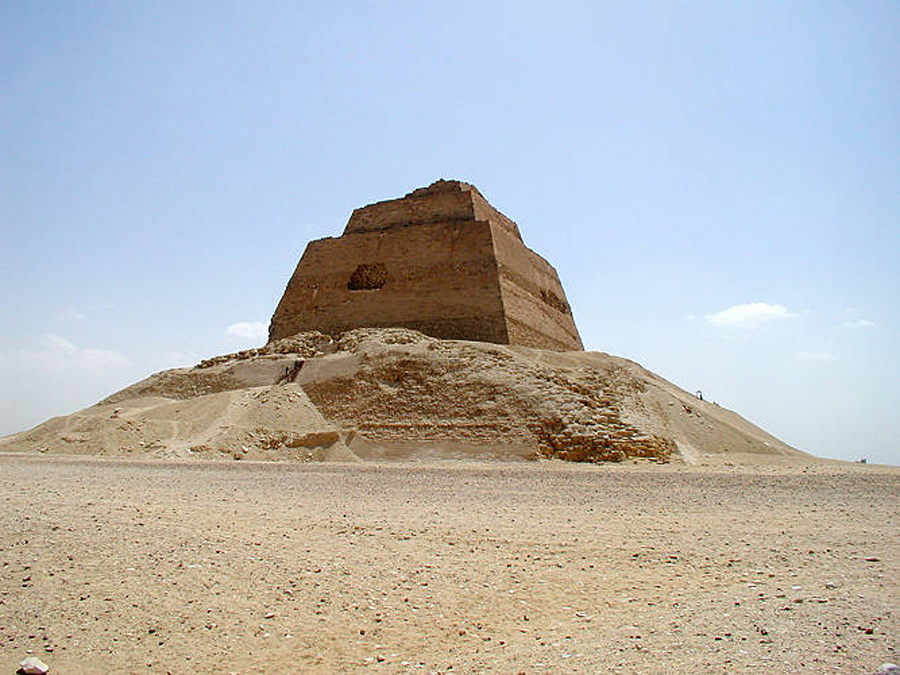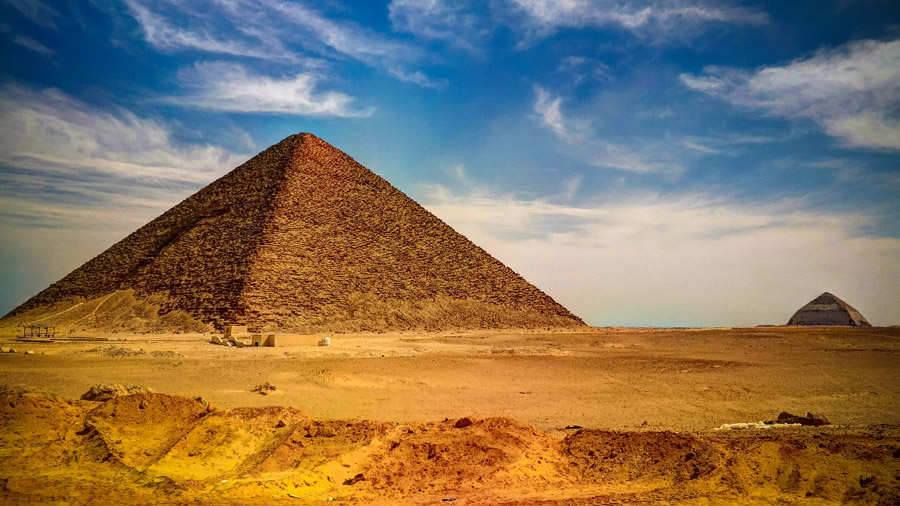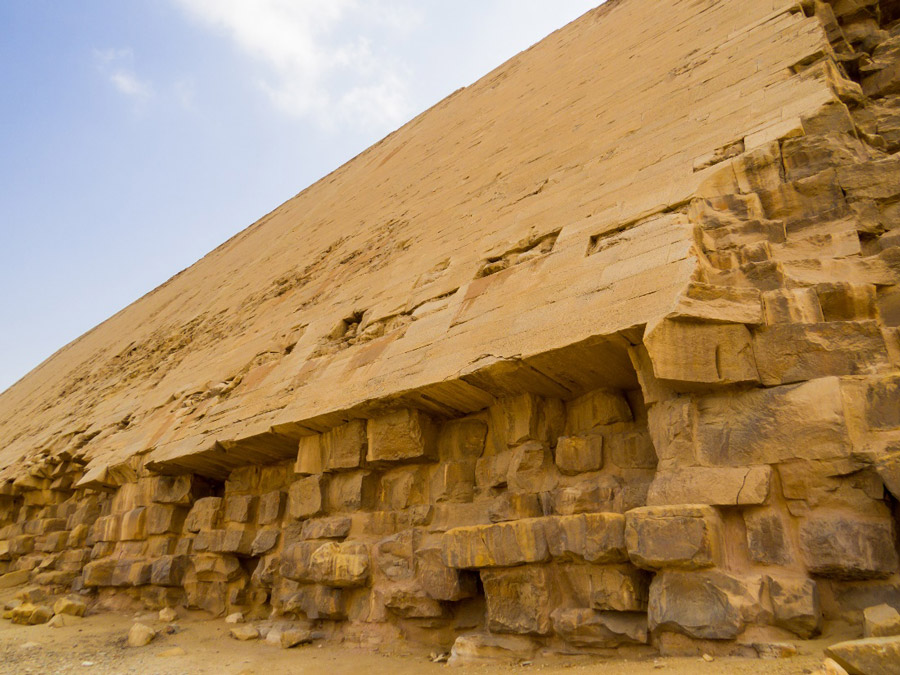One of the most unusual pyramids in the history of ancient Egypt, the pyramid of Sneferu was one of the first pyramids that was built, located at the Egyptian royal necropolis at Dahshur. It is unique among pyramid development in Egypt.
The Ancient Egyptian name of the pyramid was “The Southern Shining One.” It was called so because it was constructed with polished and shining Tura limestone.
Sneferu, an Egyptian Old Kingdom Pharaoh, constructed the Bent Pyramid in around 2600 BC. Sneferu was the founder of the Fourth Dynasty, and his stepson Khufu oversaw the construction of the great pyramid at Giza in later years.
The pyramid was built in the desert on Nile’s west bank, 40 km (25 miles) south of Cairo. Pyramids had until this point been built on fertile land, but this represented something new. And instead of being constructed in a perfect pyramid shape, the walls bend inwards for the top section.
The Bent Pyramid is among only five of the old kingdom pyramids that remain in their original form, even after 4,500 years of construction. The pyramid even retains its limestone casing which would make it shine in the desert sun.
Why is the Pyramid Bent?
The pyramid is known as Bent Pyramid owing to the steep change in its slope. The walls of the lower part of the pyramid rise at an angle of 54 degrees. Then, at about 49 m (161 feet) above the base, there is an abrupt flattening of the slope to 43 degrees. This gives the pyramid its distinctive bent shape.

There are several theories relating to the change in the slope’s angle. One of the prominent theories is that Snefuru intentionally reduced the slope angle after he received news of the collapse of a pyramid at Meidum.
Another popular theory suggests that the pyramid took a lot of time to be built. To speed up construction and complete the pyramid faster, Sneferu may have reduced the pyramid’s angle.
- Treasure of the Sands: Lost Egyptian “Golden City” Found near Thebes
- The Mysterious “Set”: An Ancient Egyptian Cryptid?
Some scholars even believe that the odd shape of the Bent Pyramid was intentionally planned for some religious reasons. However, most Egyptologists have dismissed this theory relating to the shape of the pyramid.
Layout of the Bent Pyramid
A yellowish-grey enclosure wall, made of limestone, surrounds the pyramid complex. The main pyramid, a small temple, a satellite pyramid, and a small courtyard line up within the wall.
The Bent Pyramid itself consists of two entrances. The first entrance of the pyramid lies towards the north and is 12 m (39 feet) above ground level. Wooden stairways have been constructed to provide the tourists with optimum convenience.
The second entrance of the pyramid is towards the west and leads, like the first, to a chamber with a corbelled, high roof. While the chamber of the northern entrance is below the ground level, the chamber of the western entrance is constructed on the body of the Bent Pyramid.
These high vaulted ceilings, although relatively common in later pyramid construction, may have posed problems of structural stability. It may have been this uncertainty about the pyramid which led to the change in angle for the top portion.
The Surroundings
A causeway, paved with limestone blocks, runs from the northeast of the Bent Pyramid towards the small temple. On each side of the causeway runs a low limestone wall, a little curved at the top.
Many believe that the Bent Pyramid may also have a second causeway that links the complex to the landing stage or a dock. However, no trace of a second causeway has been discovered to date.

Towards the east of the Bent Pyramid, some fragmentary remains of the pyramid temple have been found. Similar to the Meidum pyramid’s temple, two stelae are present behind the pyramid temple.
Moreover, no trace of any kind of inscription is found. Even though there are only fragmentary remains of the temple, it is assumed that it had a lot of similarities with the Meidum pyramid’s temple, which would support the theory that lessons learned from the construction at that complex would be applied here.
According to some Egyptologists, a satellite pyramid constructed nearby was designed to house the “ka” of the Pharoah, his “double” of the soul. Located about 55 meters (180 feet) towards the south of the Bent Pyramid, this smaller pyramid is only 26 meters (85 feet) high.
The faces of the pyramid are inclined at an angle of 44 degrees, a similar angle to the shallower top portion of the Bent Pyramid. The entire structure is built using limestone blocks arranged in horizontal rows.
The smaller pyramid contains a burial chamber, accessed through a descending corridor. A horizontal passage then connects this corridor with another ascending corridor which then leads up to a chamber. The design of these corridors is quite similar to the corridors present in the Great Pyramid of Giza.
Significance of the Bent Pyramid
The Bent Pyramid was one of its kind, a unique structure constructed in the history of ancient Egypt. It marks the glorious period in which the construction of pyramids evolved and may have been the first pyramid with smooth sides.
It is not only the most unusual pyramid in Egypt but also one of the best-preserved pyramids. Unusually large gaps between the limestone blocks covering the pyramid may have helped to preserve this casing, as the gaps would have allowed room for thermal expansion of the blocks without them touching.

Until the 19th century, there was no archaeological investigation of the Bent Pyramid. It only started in the 19th century when Egyptologists such as Lepsius, Perring, and Petrie began exploring the structure in Egypt.
These were followed by more modern investigations, including that of Ahmad Fakhry during the early 1950s. However even after so many investigations of the Bent Pyramid, several Egyptologists believe that there are secrets still to be revealed.
Whether all the chambers of the pyramid have been accurately located or not is still a question. The archaeological studies were often hindered as strong winds led to the creation of drafts through the passageways.
Owing to this, there are assumptions that some of the passageways or rooms of the Bent Pyramid may have remained undiscovered. Does this unique and ancient pyramid still have some secrets? Certainly, the remains of the Pharaoh Sneferu have never been found.
Top Image: Sneferu’s bent pyramid. Source: WitR / Adobe Stock.
By Bipin Dimri